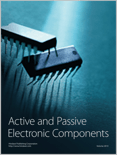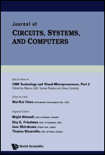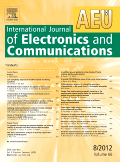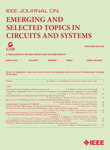
Journal of Low Power Electronics and Applications
Scope & Guideline
Connecting Ideas, Driving Low Power Innovations
Introduction
Aims and Scopes
- Low Power Circuit Design:
Research on the design methodologies and techniques for developing circuits that operate at minimal power levels, including innovations in CMOS technology and sub-threshold designs. - Energy Harvesting and Autonomous Systems:
Exploration of systems that utilize energy harvesting techniques to power low-energy devices, emphasizing sustainable and self-sufficient electronic applications. - Biomedical Electronics:
Development of low power electronic devices specifically tailored for biomedical applications, such as sensors and amplifiers for physiological signal monitoring. - Field-Programmable Gate Arrays (FPGAs) for Low Power Applications:
Investigations into the use of FPGAs in low-power contexts, focusing on architectures and implementations that maximize efficiency while maintaining performance. - Internet of Things (IoT) Solutions:
Research on low power electronics tailored for IoT applications, addressing challenges related to connectivity, processing, and energy efficiency. - Neuromorphic Computing:
Innovative approaches to computing inspired by neural systems that require low power, including memristor based designs and spiking neural networks. - Analog and Mixed-Signal Circuits:
Design and analysis of analog and mixed-signal circuits that prioritize low power consumption while achieving high performance in various applications.
Trending and Emerging
- Ultra-Low Voltage Design Techniques:
Recent publications have increasingly concentrated on ultra-low voltage designs, particularly for applications in IoT and biomedical devices, which require minimal power while maintaining functionality. - Machine Learning and AI Integration:
There is a growing trend towards integrating machine learning and artificial intelligence into low power electronics, enhancing the capabilities of devices while managing energy consumption effectively. - Energy-Efficient Wireless Sensor Networks:
Research focused on energy-efficient designs for wireless sensor networks has become prominent, addressing the need for sustainable solutions in various monitoring applications. - Advanced Energy Harvesting Solutions:
Innovations in energy harvesting technologies, including applications in wearable devices and IoT, are gaining traction as researchers explore new methods to power low-energy devices sustainably. - Smart Health Monitoring Systems:
The development of smart health monitoring systems utilizing low power electronics is trending, reflecting the increasing importance of health technology in contemporary society.
Declining or Waning
- Traditional Digital Circuit Design:
There has been a noticeable reduction in research focused solely on traditional digital circuit design, as the field shifts towards more integrated, energy-efficient solutions that incorporate analog and mixed-signal methodologies. - General Purpose Computing Architectures:
Research on general-purpose computing architectures appears to be waning, with a shift towards specialized low-power designs tailored for specific applications such as IoT and embedded systems. - High-Power Analog Circuit Applications:
The focus on high-power analog applications has diminished, as the journal emphasizes low-power solutions, leaving behind conventional high-power analog circuit discussions. - Passive Components in Circuit Design:
Studies centering on passive components in circuit design have become less frequent, possibly overshadowed by active component innovations that facilitate lower power consumption. - Wideband Communication Systems:
The emphasis on wideband communication systems has decreased, as research trends focus more on ultra-low power, narrowband solutions suitable for IoT and sensor networks.
Similar Journals

Power Electronics and Drives
Driving Innovation in Motor and Converter DesignPower Electronics and Drives is a leading journal dedicated to advancing the field of power electronics, encompassing a wide range of topics including converter designs, motor drives, and renewable energy applications. Published by SCIENDO, this journal has been proudly open access since 2016, making cutting-edge research accessible to scholars and practitioners around the globe. With a commitment to high-quality publication, Power Electronics and Drives serves as a crucial platform for researchers, professionals, and students to share their findings, fostering collaboration and innovation within the community. The journal aims to bridge the gap between theory and practical applications, thus playing an essential role in shaping the future of power electronic systems and their integration into various technologies. Located in Warsaw, Poland, this journal is poised to contribute significantly to the field and enhance knowledge dissemination across international boundaries.

Active and Passive Electronic Components
Illuminating Paths in Electrical and Materials ScienceActive and Passive Electronic Components, published by HINDAWI LTD, stands as a significant open-access journal dedicated to the fields of electrical and electronic engineering, as well as materials science, particularly focusing on electronic, optical, and magnetic materials. Established in 1985, this journal aims to disseminate high-quality research, experimental studies, and theoretical analyses that contribute to advancements in electronic component technology and applications. Despite its recent category quartile rankings of Q4 in both relevant fields as of 2023, the journal plays an essential role in providing open access to critical findings that may benefit diverse sectors including telecommunications, consumer electronics, and renewable energy systems. Researchers, professionals, and students are encouraged to engage with the latest studies published in this journal, which has seen periods of publication interruption yet remains dedicated to fostering innovative research in its scope. With a commitment to open access, articles are freely available, promoting wider dissemination and collaboration within the scientific community.

JOURNAL OF CIRCUITS SYSTEMS AND COMPUTERS
Exploring the Intersection of Hardware and ArchitectureJOURNAL OF CIRCUITS SYSTEMS AND COMPUTERS is a pivotal publication in the fields of Electrical and Electronic Engineering as well as Hardware and Architecture, published by World Scientific Publishing Co. Pte Ltd in Singapore. With an ISSN of 0218-1266 and an E-ISSN of 1793-6454, this journal has contributed significantly to the discourse surrounding innovative research and technological advancements since its inception in the late 1990s. It currently holds a Q3 ranking in both relevant categories, reflecting its competitive stature and providing researchers, professionals, and students a substantial platform for disseminating findings. The journal covers a diverse range of topics, focusing on the design, analysis, and application of circuits, systems, and advanced computing technologies. Authors benefit from a rigorous peer-review process, ensuring high-quality publications that drive the field forward. The journal's commitment to excellence underscores its importance in fostering academic collaboration and knowledge exchange, making it a vital resource for anyone dedicated to advancing the domains of electrical engineering and computer science.

AEU-INTERNATIONAL JOURNAL OF ELECTRONICS AND COMMUNICATIONS
Elevating Knowledge in Electronics and Communication.AEU - International Journal of Electronics and Communications, published by Elsevier GmbH, is a leading peer-reviewed journal that has become an essential resource for scholars and professionals in the fields of electronic communications and electrical engineering. With an impressive impact factor reflective of its rigorous scholarship, the journal holds a Q2 ranking in the category of Electrical and Electronic Engineering, placing it in the top tier of its field. This journal primarily focuses on publishing innovative research, reviews, and advancements that facilitate the convergence of electronics and communication technologies. As it strides through various converged years, from 2001 to 2024, AEU delivers critical insights and cutting-edge developments to a global audience, encouraging collaboration among researchers and practitioners. With its accessible platform, researchers are invited to contribute their findings and to stay abreast of the latest trends and discoveries in this dynamic field, strengthening the journal’s vital role in shaping the future of electronics and communications.

ELECTRICAL ENGINEERING
Exploring Breakthroughs in Electrical and Electronic EngineeringELECTRICAL ENGINEERING is a distinguished journal published by Springer that addresses the multifaceted challenges and advancements in the field of electrical and electronic engineering. With an impact factor that reflects its significance in the academic community, this journal offers vital insights into emerging technologies and groundbreaking research findings. Operating without open access, it provides a platform for rigorous peer-reviewed articles that span from applied mathematics to engineering disciplines. The journal has established a strong reputation, ranking in the Q2 category for Electrical and Electronic Engineering and Q3 for Applied Mathematics as of 2023, which showcases its commitment to high-quality research. The journal is indexed in Scopus, placing it within the 53rd to 71st percentiles in its respective categories. Researchers, professionals, and students alike will find ELECTRICAL ENGINEERING an invaluable resource for staying abreast of innovations and developments that shape the future of the electrical engineering landscape.

Revue Roumaine des Sciences Techniques-Serie Electrotechnique et Energetique
Illuminating the path to sustainable energy advancements.Revue Roumaine des Sciences Techniques-Serie Electrotechnique et Energetique is a distinguished journal published by EDITURA ACAD ROMANE, focusing on the vital fields of Electrical and Electronic Engineering and Energy studies. With a notable history since its inception in 1969, this journal serves as a significant platform for disseminating research and advancements in these disciplines, particularly within the context of Romanian and broader European scientific communities. Although it operates on a traditional access model, it maintains relevance with a Q3 quartile ranking as of 2023 in both the Electrical and Electronic Engineering and Energy categories. With its inclusion in Scopus rankings indicating its growing influence, Revue Roumaine des Sciences Techniques actively contributes to the body of knowledge, providing valuable insights and fostering innovations that resonate with researchers, professionals, and students alike. The journal encourages submissions that address contemporary challenges and developments in technology and energy management, facilitating a collaborative exchange of knowledge that is crucial for both academic and practical applications.

Jordan Journal of Electrical Engineering
Fostering Dialogue in Electrical Engineering ExcellenceJordan Journal of Electrical Engineering, published by TAFILA TECHNICAL UNIVERSITY (TTU) in Jordan, serves as a critical platform for disseminating groundbreaking research in the fields of electrical engineering, energy systems, and related disciplines. With an ISSN of 2409-9600 and an E-ISSN of 2409-9619, the journal is committed to promoting advancements in energy engineering, biomedical applications, control systems, and signal processing among others. Despite its recent establishment in 2023, it has been indexed in multiple categories within Scopus, receiving rankings that reflect its emerging role in the academic community. Researchers and professionals are encouraged to contribute and access cutting-edge articles through open access options, ensuring that knowledge is readily available to all interested parties. As the journal continues to grow, it aims to bridge gaps in knowledge and stimulate dialogue, thereby supporting innovation and practical applications in the engineering sector.

Electronics
Unveiling Insights in Electronics and CommunicationElectronics, published by MDPI since 2012, stands as a pivotal open-access journal that caters to a wide spectrum of disciplines within the electrical and electronic engineering domain. With a strong commitment to disseminating innovative research, this journal has garnered notable recognition, achieving a Q2 ranking in multiple pertinent categories, including Computer Networks and Communications, Control and Systems Engineering, and Signal Processing. Its editorial standards and open-access format enhance the visibility and accessibility of high-quality research, making critical advancements in technology available to a global audience. Located in Switzerland, the journal is positioned to foster international collaboration and dialogue among researchers, professionals, and students dedicated to exploring the evolving landscape of electronics and its applications. With an E-ISSN of 2079-9292, the journal is meticulously indexed in reputable databases like Scopus, further solidifying its relevance and influence in the engineering community.

IEEE Journal on Emerging and Selected Topics in Circuits and Systems
Exploring the forefront of electrical engineering.IEEE Journal on Emerging and Selected Topics in Circuits and Systems is a prestigious peer-reviewed journal published by the IEEE - Institute of Electrical and Electronics Engineers, aimed at advancing the field of electrical and electronic engineering. With its ISSN of 2156-3357 and E-ISSN of 2156-3365, this journal has established itself as a leader in the exploration of innovative concepts and applications within circuits and systems since its inception in 2011. It is recognized for its high impact factor, being categorized in the Q1 Quartile for electrical engineering in 2023, and is ranked 126 out of 797 journals in the field, placing it in the 84th percentile according to Scopus rankings. As a valuable resource for researchers, professionals, and students alike, the journal focuses on emerging technologies and selected topics that contribute to the evolution of circuit designs, signal processing, and system architecture. Although it does not offer open access, the relevance and content of the journal ensure it remains at the forefront of electrical engineering discourse, continually fostering innovation and knowledge dissemination among the scientific community.

Advances in Electrical and Electronic Engineering
Pioneering the Future of Electronics ResearchAdvances in Electrical and Electronic Engineering is a distinguished peer-reviewed journal published by VSB-TECHNICAL UNIVERSITY OSTRAVA, fostering an open-access platform since 2002 that is instrumental in disseminating innovative research and developments in the field of electrical and electronic engineering. With an ISSN of 1336-1376 and an E-ISSN of 1804-3119, this journal provides a vital resource for researchers, professionals, and students striving to stay at the forefront of this dynamic sector. Despite its present Q4 ranking in the Electrical and Electronic Engineering category and a Scopus rank of 598 out of 797, the journal aims to elevate its impact and reach through dedicated contributions that explore emerging technologies, theoretical advancements, and practical implementations. With its commitment to accessibility, authors are encouraged to publish work that can significantly advance our understanding of electrical systems and contribute to the global engineering community from its base in Czech Republic.